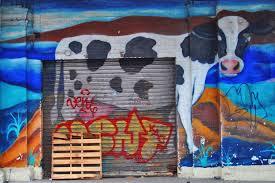 I've just come back from visiting my new neighbor, the Whitney Museum smack there on the river, just a few blocks from where I've lived my whole grown up life.
I've just come back from visiting my new neighbor, the Whitney Museum smack there on the river, just a few blocks from where I've lived my whole grown up life.
In the film of my memory I can still see that eighteen-year-old running away from home on the BMT into 'the City', because all she ever wanted was to live in Greenwich Village.
My $99-a-month salary as an assistant in a nursery school did not afford me a Village idyll of a brownstone on a pretty tree-lined street. But I did find a place that I still call home, right on the cusp of the Village, on the edge of the meatpacking district. No one wanted to live over here.
This was the 1970's, exciting, dangerous times for a girl to be on her own. To get to the 'old' Western Beef on 14th Street (with its sawdust floors) to buy a bag of ground beef at 99 cents-a-pound, I'd have to weave between huge beef carcasses swinging from hooks on Washington Street, and leather bar denizens, weaving home in the morning after a night carousing on the abandoned docks.
My cobbled backwater stayed sleepy until the tracks of the High Line were exposed in 2006. And in 2011, when the charming cow murals covering Premier Veal on West Street were knocked to make way for the Whitney. There wasn't a day I didn't run Bob Dylan singing, "the times they are a-changin'" in my head.
The only place not bothered by the pandemonium of both constructions was the corner deli on Horatio Street where the line was so long in the morning I took to smacking two fifty on the counter for the Times and making a dash, so the hungry workers snaking in the door seeking hoagies wouldn't think I was jumping the line.
Now four years onward there stands the Whitney - clean, huge, gray, glassy, classy. I sometimes wonder if the Spirits who inhabit the art they're depicted in have any memory of the old neighborhood.
How dark Washington Street was. How the Irish gangs defended their hard-earned territory with fists. How Frank's Steaks on 14th street always had a line of black town cars (rumored to be Mafia) out front, because taxis never came over here.
And so it came to pass, with a hopeful heart and a Founding Member black card in hand, on a Matisse-blue morning, I approached my new neighbor anchoring the corner of Gansevoort Street by the shores of the mighty Hudson.
Beginning at the top floor and working downward, I greeted old friends. John Sloan, Edward Hopper, and my once-upon-a-time neighbor, Roy Lichtenstein - a nice man - happy to see that they made the cut from uptown to the Village. Yet what really grabbed me were the massive windows and terraces giving an elegant perspective to the neighborhood and beyond.
From the North to the South, to the East and the West, new girl in town, Gertrude Whitney, once the belle of turn of the century New York art scene, is entwining herself around the meatpacking district, up to Chelsea, down to Miss Liberty, all the way across farthest New Jersey and onward to America.
"America Is Hard To See" I thought, contemplating the title of this inaugural exhibit. Yet, as I wandered around, moving from Joseph Cornell to Basquiat, I found myself being drawn back to a West-facing window, that by its position alone has transmogrified the Bauhaus-like yellow brick, New York City Department of Sanitation building, into a Hopper-like painting.
This elegance of the view, complemented by the Matisse-blue sky and the gray-green Hudson, gave me such a clear portrait of America now. How it will change through different weathers and seasons. I had to leave to get my bearings on a south-facing terrace.
Across the way, in a large warehouse, now apartments, my eye caught a glimpse of a young girl in a window. She was lolling in a large cushy chair. All I could see were her bare legs and feet, her hand clasping a cell phone. I stared at her changing the position of her legs several times, indicating that what she was hearing was terribly exciting.
America is hard to see. Yet here was I seeing a little snippet of it in the now with a girl on a cell phone. Were Hopper alive he surely would have painted her. She remains forever in my mind.
